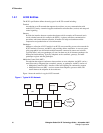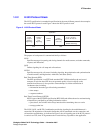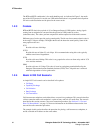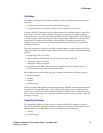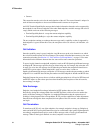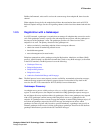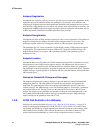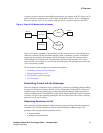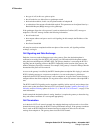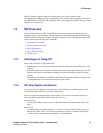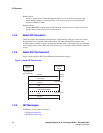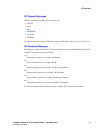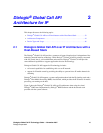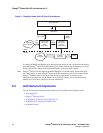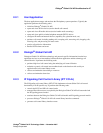38 Dialogic
®
Global Call IP Technology Guide — November 2007
Dialogic Corporation
IP Overview
• the type of call; in this case, point-to-point
• the call model to use, either direct or gatekeeper-routed
• the destination address; in this case, the phone number of endpoint B
• an estimation of the amount of bandwidth required. This parameter can be adjusted later by a
Bandwidth Request (BRQ) message to the gatekeeper.
If the gatekeeper allows the call to proceed, it sends an Admission Confirm (ACF) message to
endpoint A. The ACF message includes the following information:
• the call model used
• the transport address and port to use for call signaling (in this example, the IP address of the
gateway)
• the allowed bandwidth
All setup has now been completed and the next phase of the scenario, call signaling and data
exchange, can begin.
Call Signaling and Data Exchange
Endpoint A can now send the Setup message to the gateway. Since the destination phone is
connected to an analog line (the PSTN), the gateway goes off-hook and dials the phone number
using dual tone multifrequency (DTMF) digits. The gateway therefore is converting the H.225.0
signaling into the signaling present on the PSTN. Depending on the location of the gateway, the
number dialed may need to be converted. For example, if the gateway is located in Europe, then the
international dial prefix will be removed.
As soon as the gateway is notified by the PSTN that the phone at endpoint B is ringing, it sends the
H.225.0 Alerting message as a response to endpoint A. As soon as the phone is picked up at
endpoint B, the H.225.0 Connect message is sent to endpoint A. As part of the Connect message, a
transport address that allows endpoint A to negotiate codecs and media streams with endpoint B is
sent.
The H.225.0 and H.245 signaling used to negotiate capability, initiate and call, and exchange data
are the same as that described in the basic H.323 call scenario. See the Capability Exchange, Call
Initiation, and Data Exchange phases in Section 1.2.4, “Basic H.323 Call Scenario”, on page 32 for
more information.
In this example the destination phone is analog, therefore, it requires the gateway to detect the ring,
busy, and connect conditions so it can respond appropriately.
Call Termination
As in the basic H.323 call scenario example, the endpoint that hangs up first needs to close all the
channels that were open using the H.245 CloseLogicalChannel message. If the gateway terminates
first, it sends an H.245 EndSessionCommand message to endpoint A and waits for the same
message from endpoint A. The gateway then closes the H.245 channel.



